Some of the links in this post may be affiliate links.
Are you wondering how to make a rubber plant bushy? Many of my readers have reached out to me asking this exact question. Perhaps you have a single-trunk rubber tree plant (Ficus elastica) and you want a fuller, bushier plant. Keep reading because this honestly will be one the easiest things you can do!
I will show you some real-world examples with photos so that you can see exactly what to expect.
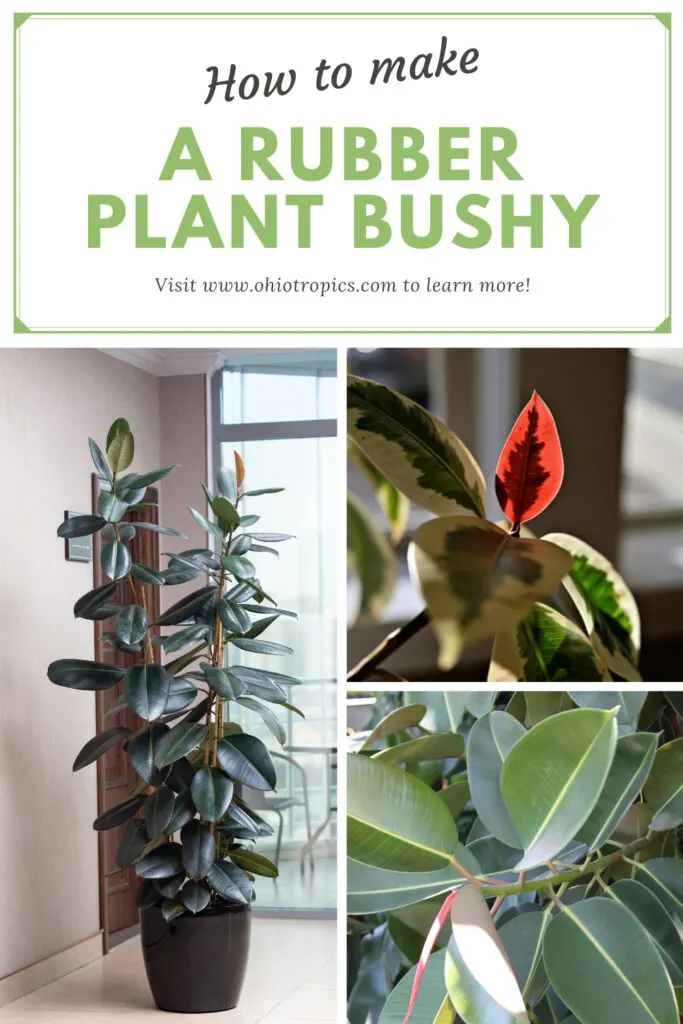
Table of Contents
HOW TO FORCE SIDE SHOOTS ON A RUBBER TREE
If you give your rubber tree the right conditions, you will eventually be forced to prune it if you want it to still fit in your home.
Indoor rubber plants can get very large! (Remember that these are gigantic trees in their natural habitat of Nepal, China and Malaysia).
So it makes sense that they can quickly outgrow our indoor spaces.
Here is my rubber plant that I’ve had for years and it has almost reached the vaulted ceiling in my living room.
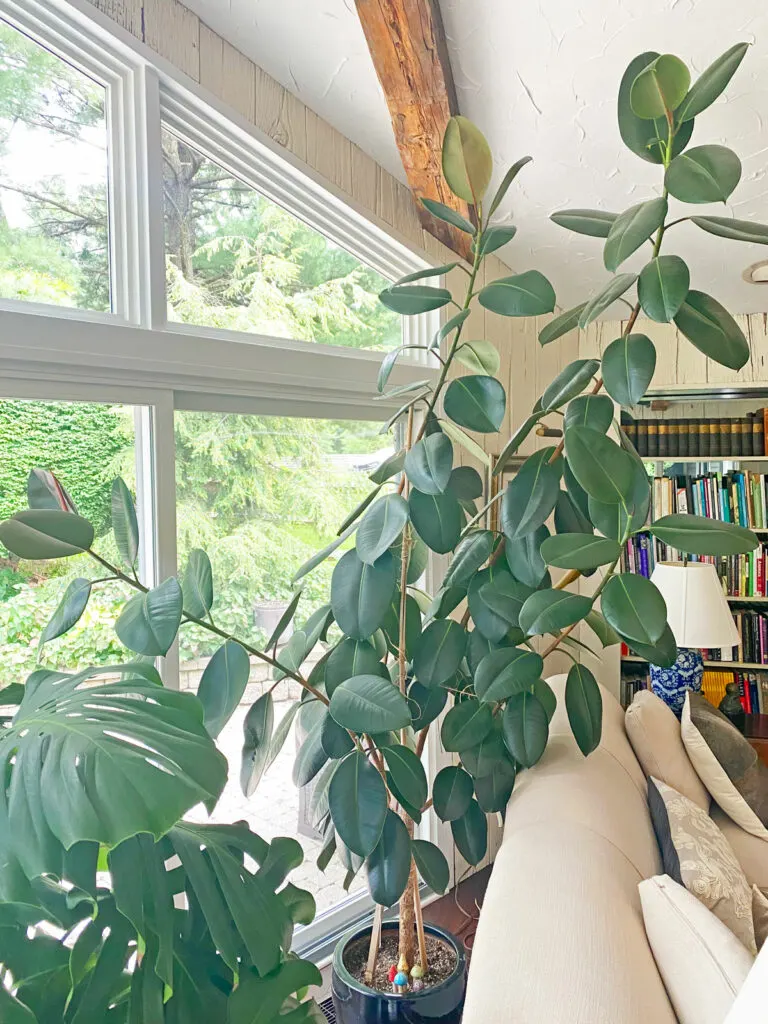
And it is by pruning your plant that you will encourage new branches so that you can achieve a more bushy rubber plant.
I will be forced to prune this plant soon because it has just about reached the ceiling.
You don’t have to wait until you’re forced to chop off your plant though. You can prune even a young plant in order to encourage branching.
Before I show the results on a younger plant, take a closer look at the same plant that I showed in the photo above.
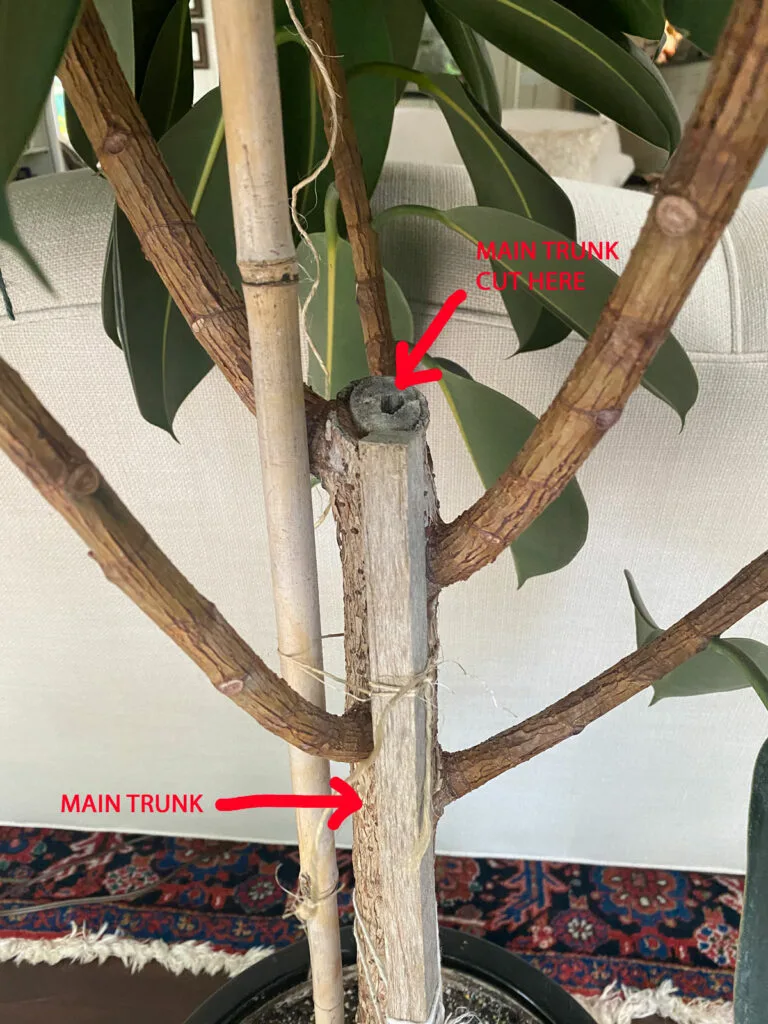
You can clearly see the one main trunk of my rubber plant and where it was cut off a long time ago. It resulted in several side branches that sprouted from the main trunk.
Once my rubber plant reached the ceiling, I pruned it back and it resulted in the following.
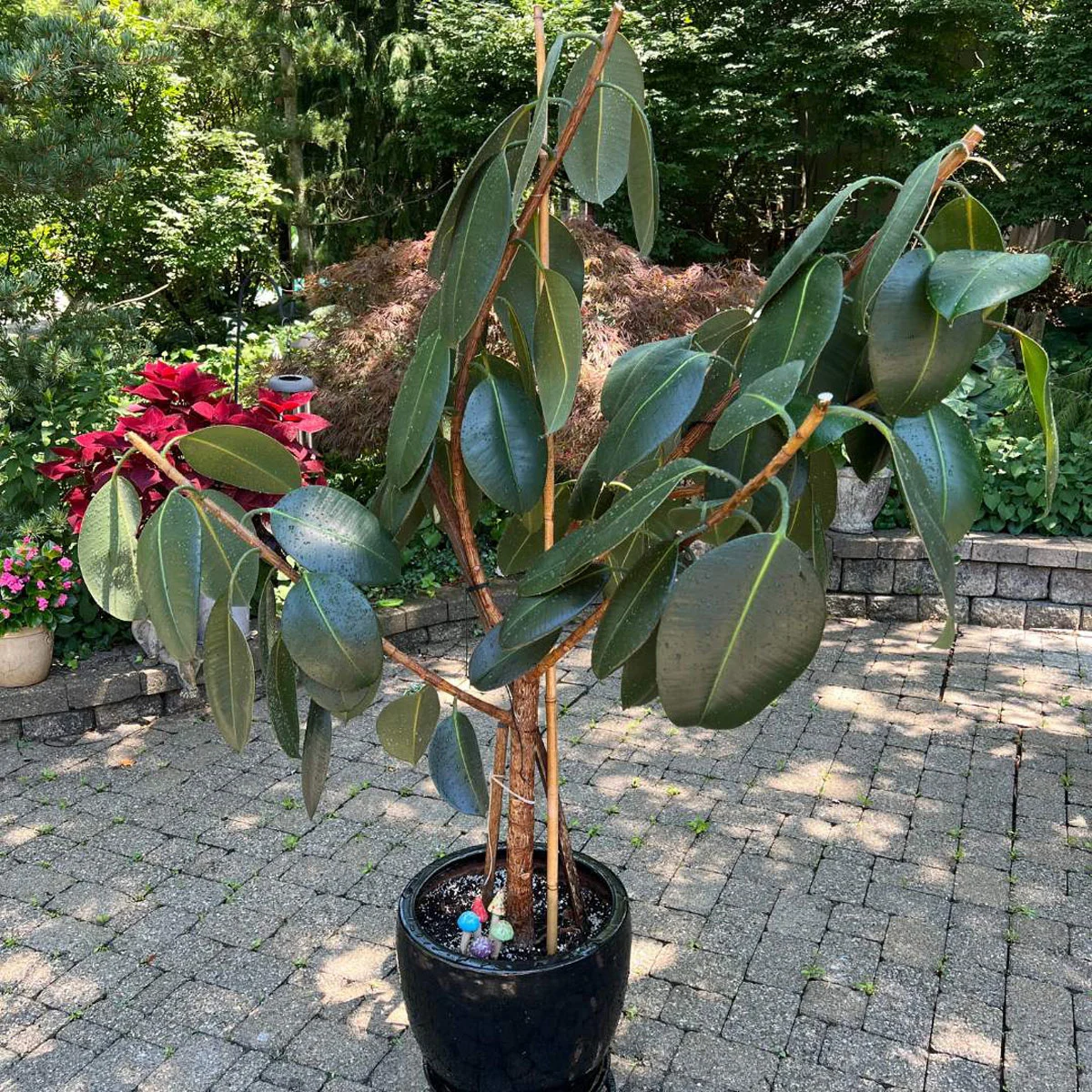
The beauty of pruning is that often times, each branch that you prune will result in two new branches, thus making your plant bushier.
This will not happen all the time, but it often does. In the photo below, you can see my own plant. I pruned the original stem where my finger is. You can clearly see two new branches that have grown after pruning.
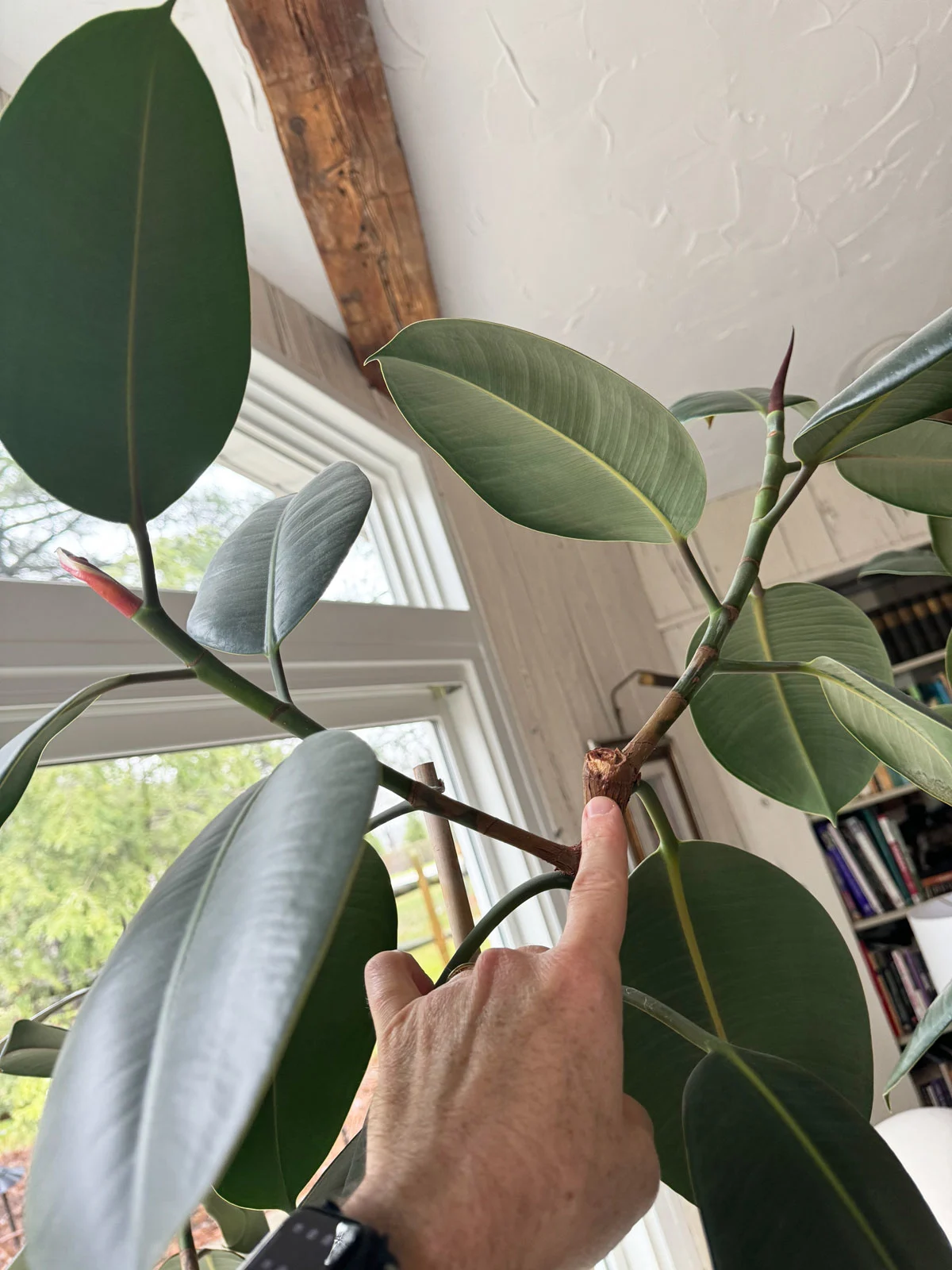
HOW TO MAKE A RUBBER PLANT BUSHY BY PRUNING
Now let me show you another example of a much smaller rubber plant that was pruned, and the resulting new growth.
One of my readers took my advice to chop off the top of her Ficus ‘Ruby’ to encourage new branching, and the results were beautiful!
Here is the how the original plant looked. It was a single-trunked plant and the owner wanted some branching on her plant.
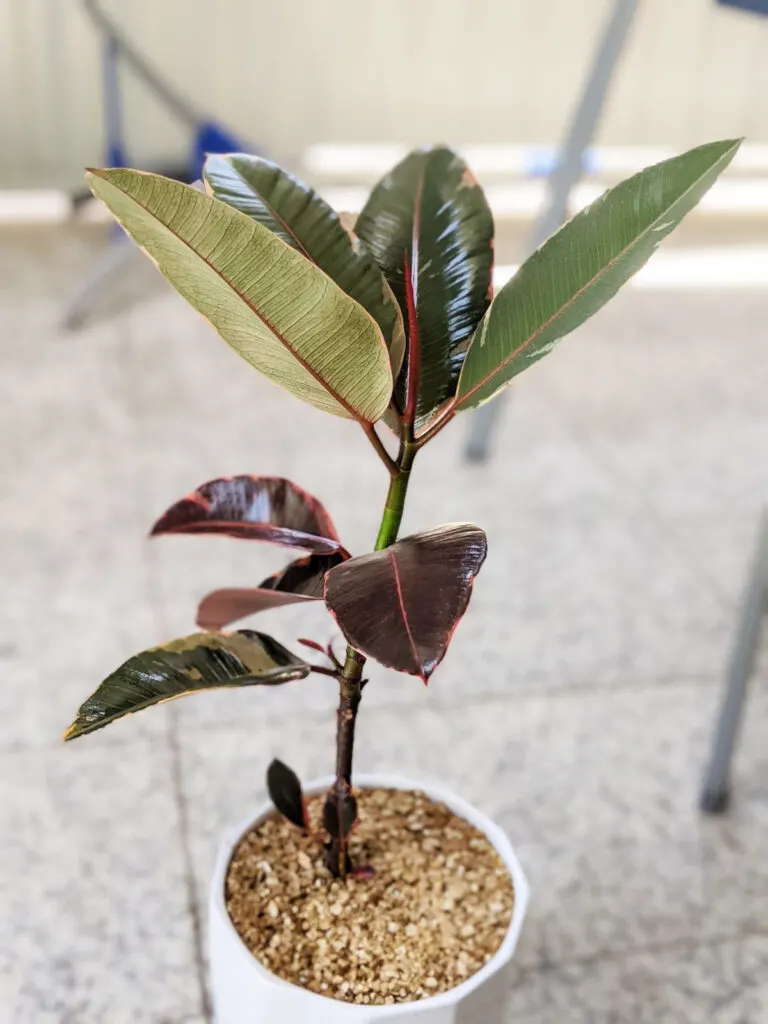
So she heeded my advice to chop the growing tip of the plant off. Take a look at the photo below. You can see where the tip of the main trunk was cut off and two new, super pink branches that formed at the leaf nodes!
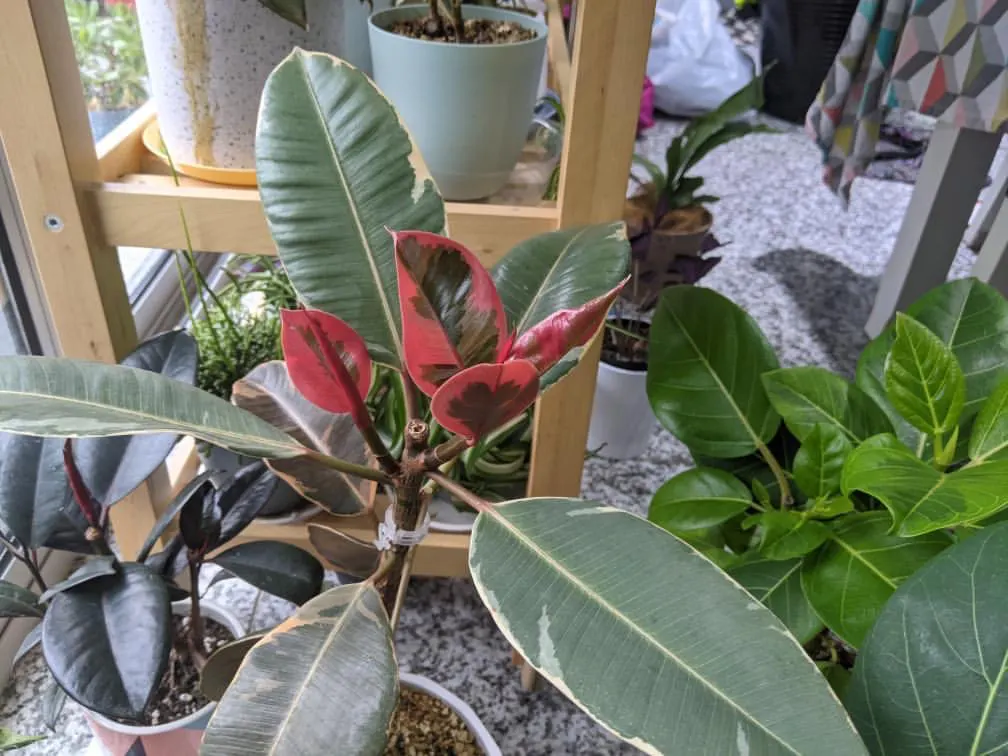
PRUNING & PROPAGATING
You first need to decide where you want to cut your trunk off. You will get at least two new branches growing right below where you cut it, and you may also get more below that as well!
After you prune it, be sure the original plant still has at least a couple leaves left. For larger rubber plants, leave more.
Here are 3 options you have when pruning your rubber plant to encourage bushier growth:
1. Cut it off and discard
If you don’t wish to propagate your plant, prune your rubber plant and discard the parts that you chopped off.
2. Propagate in water or soil
If the trunk of the part that you wish to cut off is still flexible and not woody (and the cutting is not too big), you can make a stem cutting and try and propagate in water.
Wait until the cut end stops oozing out latex (see the later section in this post on rubber plant sap) and then add to a jar of water.
Once it has roots, you can plant it in a small pot that has drainage holes.
You can also place the cutting in a pot with soil instead of rooting it in water first. Keep the potting mix moist and increase the humidity.
You can increase the humidity with a clear plastic bag loosely placed over the cutting (but not touching the leaves). Placing your rooting cuttings on a heating mat will also speed up the growth rate of new roots.
3. Air layer your plant before cutting it off
If you still wish to propagate your plant and you have a very mature plant with woody stems, the best way to get a new plant is to air layer the top portion. I have a post showing how to air layer a rubber plant if you want to explore this option.
Propagation by air layering is really the only safe option when you have really mature, woody stems.
It is also a wonderful way to rejuvenate a leggy rubber plant that has lost a lot of its lower leaves.
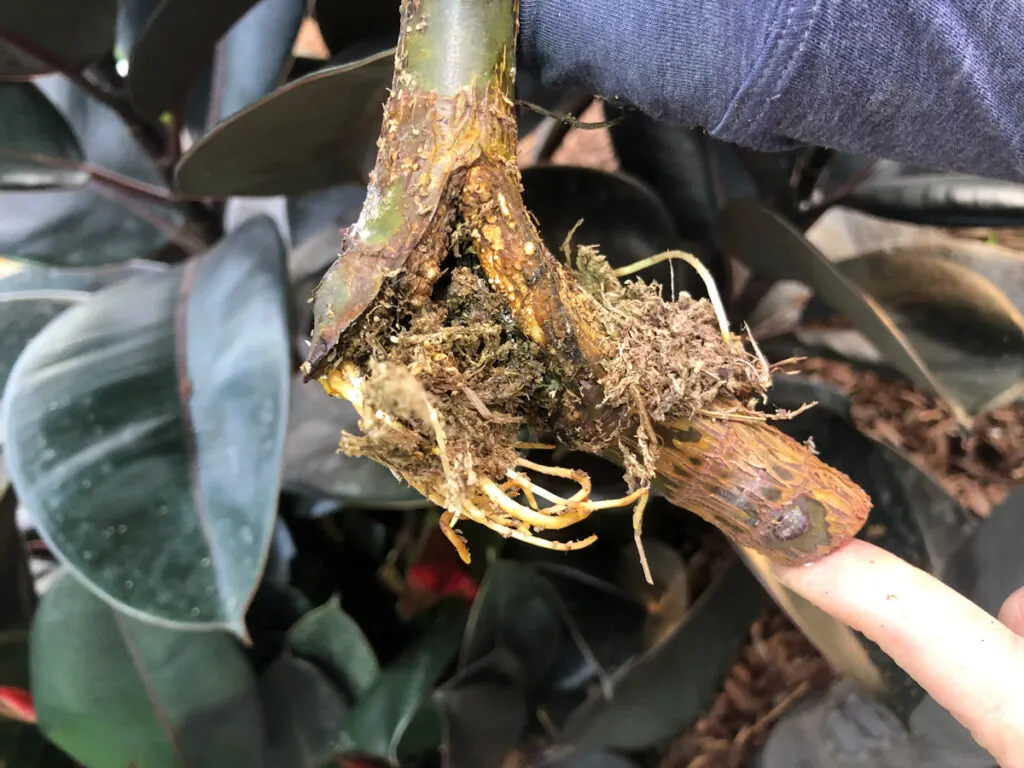
WHEN TO PRUNE RUBBER PLANT
The best time is to do it is during the active growing season.
Early spring to early summer is a great time to do it.
This will give your plant a chance to grow new branches and leaves, and get established before light levels start to decrease in fall and winter and the growth rate slows down.
CAN I CUT THE TOP OFF MY RUBBER PLANT?
Yes! Remember, new branches will start growing right below wherever you cut. So prune accordingly wherever you want branching to occur.
CAN I PLANT TWO RUBBER PLANTS TOGETHER?
Yes! This is an instant way to get a fuller rubber plant, and if you prune those plants, as outlined in this post, you will get an even fuller plant.
RUBBER PLANT SAP
Keep in mind that when you cut anything off of a rubber plant, it will secrete a milky white sap known as latex. You may want to wear gloves since the latex will cause skin irritation. Rubber gloves work wonderfully.
I would also recommend having a small cloth available anytime you prune your rubber plant. The latex will start to drip immediately and will make a mess.
If you get any latex on your skin, be sure to immediately wash the area with soap and water.
RUBBER PLANT CARE TIPS
If you’ve had your rubber plant in a dark location and you’ve gone through the trouble to prune it with the intent to make it bushier, do yourself a favor and make sure that you give it the proper care, especially by giving it enough light and proper attention to watering, otherwise you may be disappointed with the results.
Rubber plants are not low light plants. Keeping them in low light will result in a sparse plant with weak, spindly stems. Indoors, it is best if you can give them plenty of bright light, including at least a few hours of direct sunlight.
They can grow perfectly well indoors in very bright, indirect light, but they will be more robust and have a better growth rate if you can give them a sunny spot.
In addition, if your plant has suffered leaf drop, there are many causes for this and it is important to understand these causes so that you can have a nice, full and bushy plant.
For more detailed care tips and troubleshooting information on this plant, please visit my extensive blog post: Rubber Plants: Ultimate Growing Guide and 16 Common Problems.
And don’t miss my post on all the beautiful rubber plant varieties out there!
I hope you’ve enjoyed this blog post on how to make a rubber plant bushy, and don’t be afraid to make regular pruning a part of your rubber plant care routine!

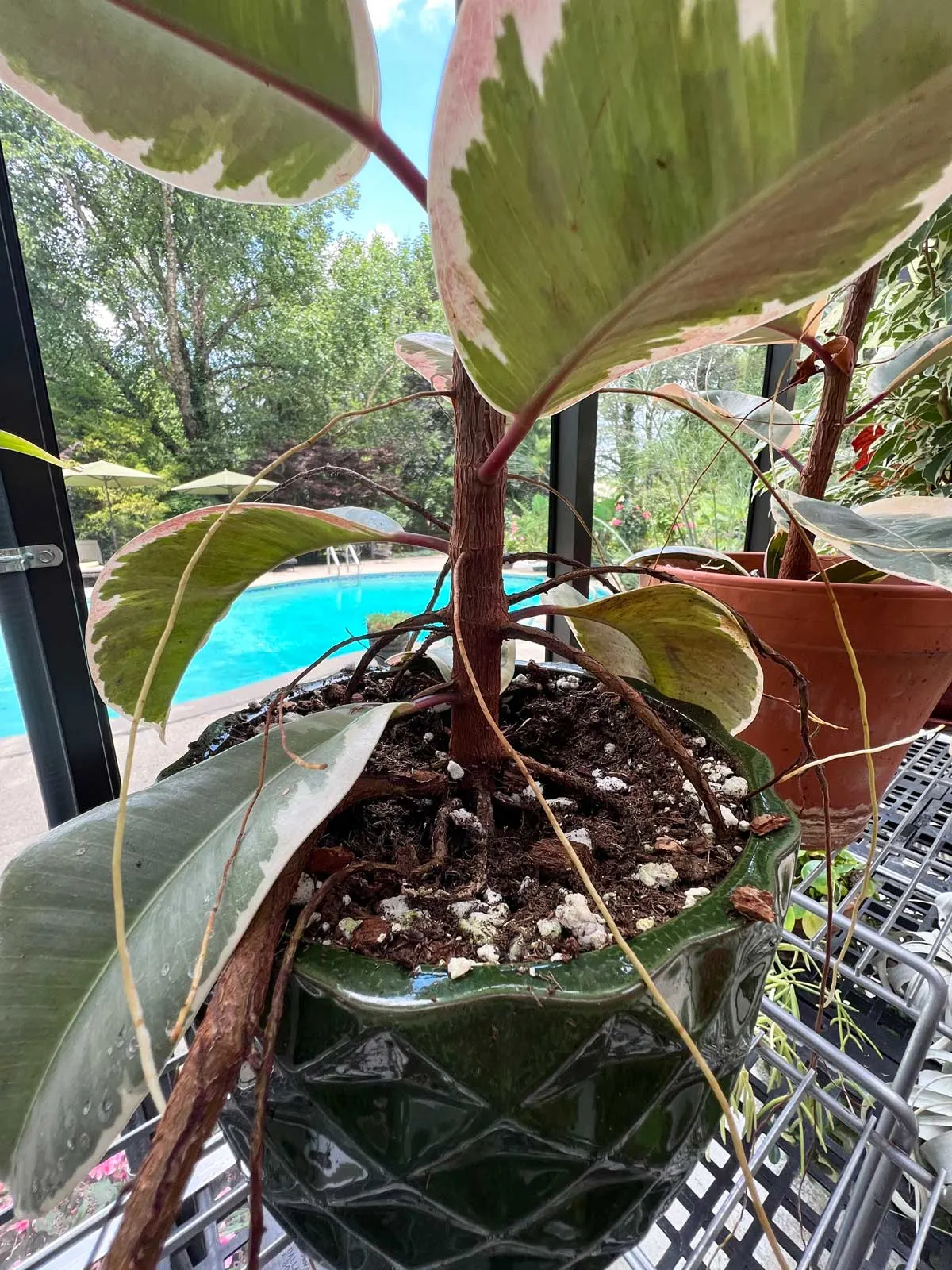
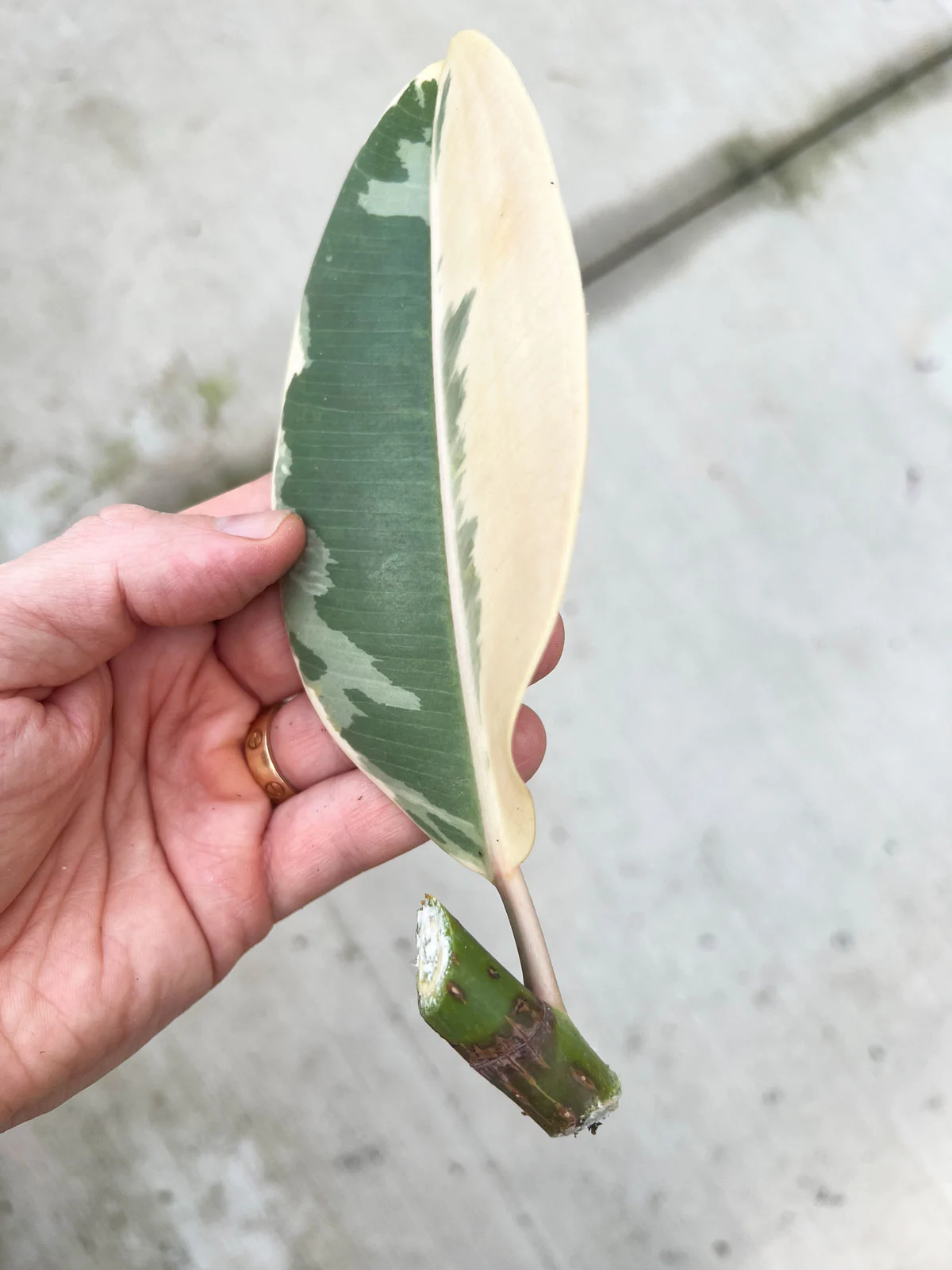
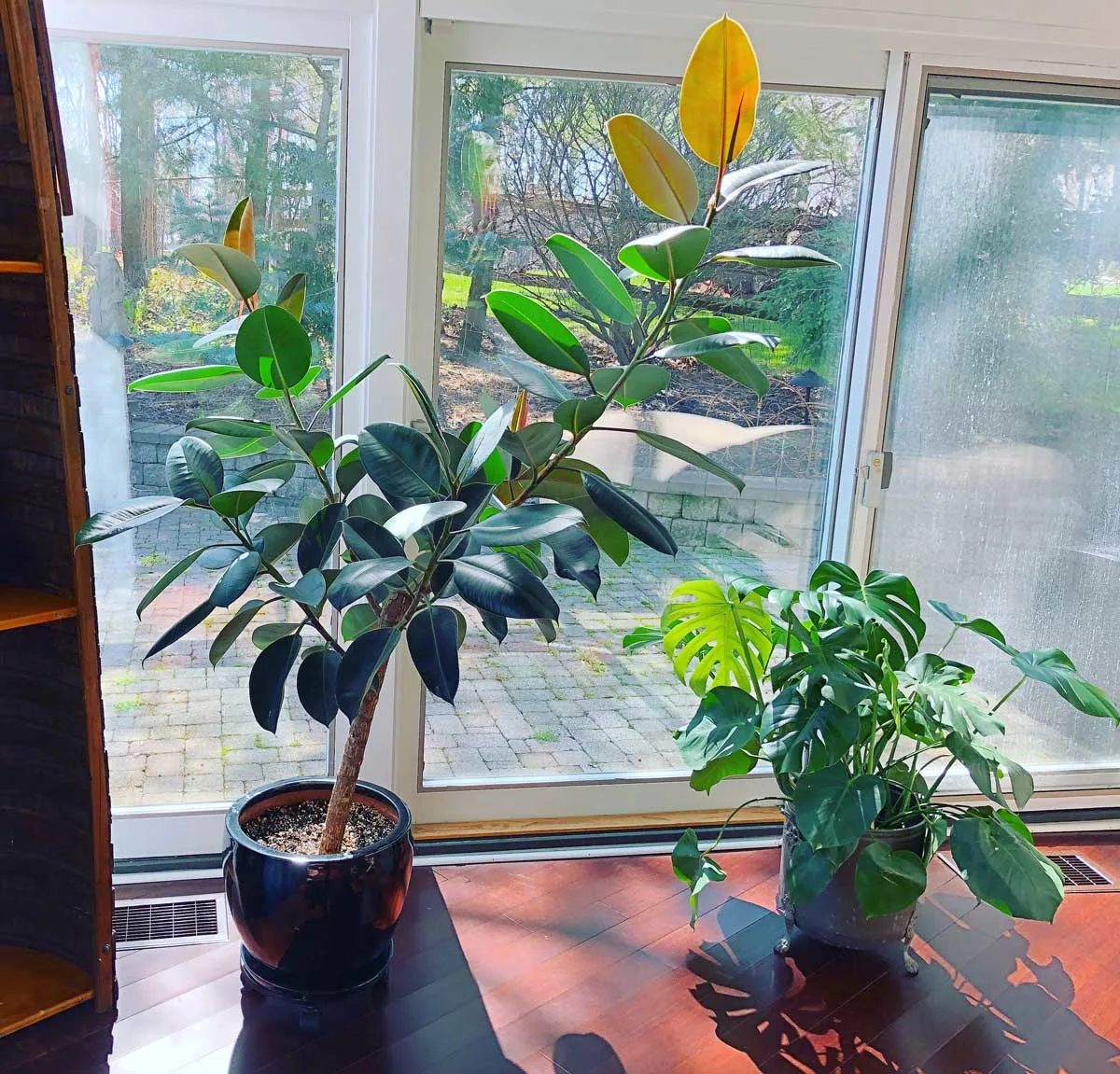
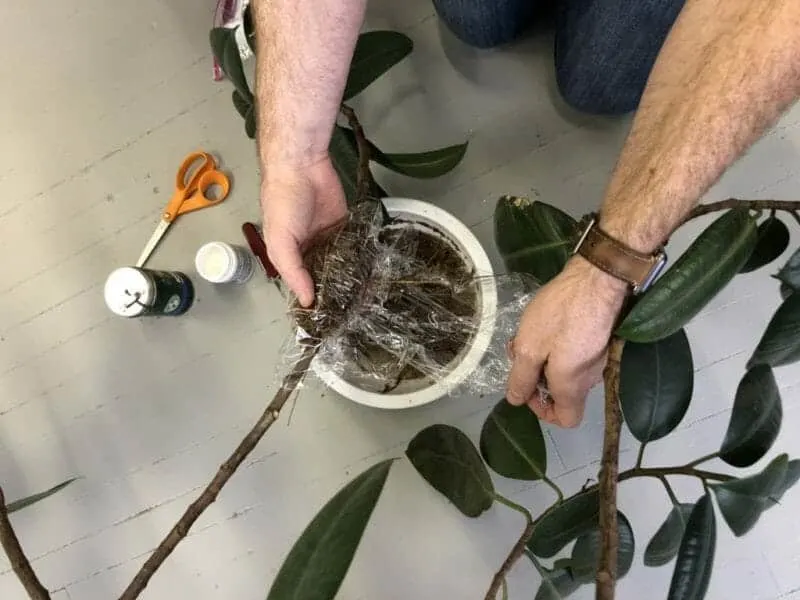
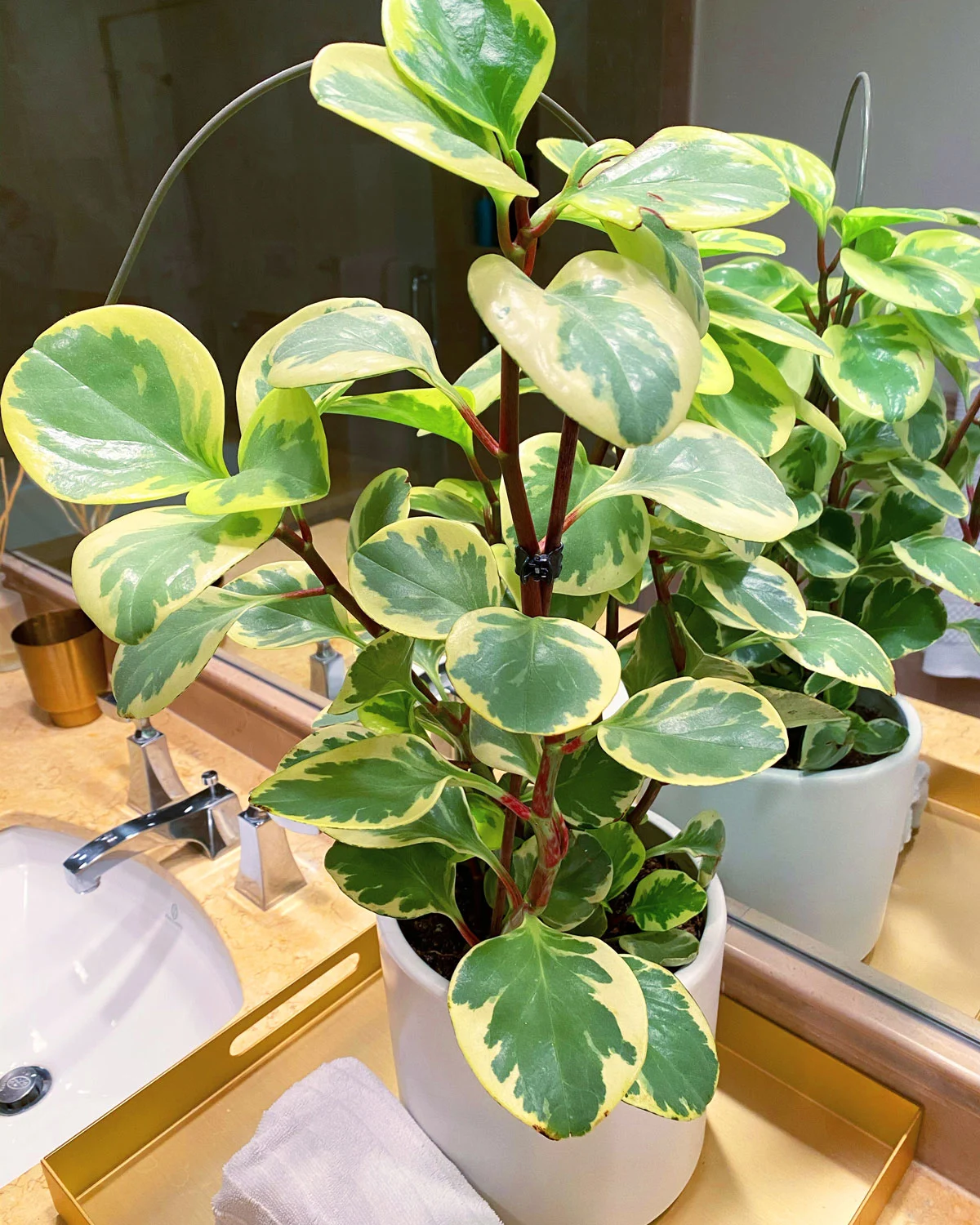
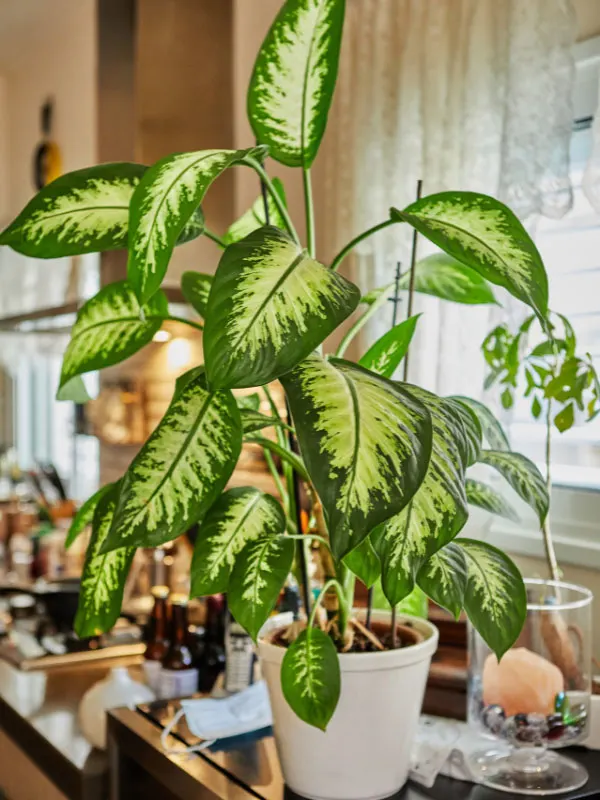
Laura
Sunday 8th of October 2023
This is so strait forward and helpful! My rubber tree is at least 3 ft tall now, I’m not sure where to cut…I don’t want the bushiness to start too far up, but don’t want to sacrifice a large portion of it by cutting low. Any tips?
Raffaele
Sunday 8th of October 2023
Glad you enjoyed the post Laura! Just remember that over time, it will be worth it if you want a bushy plant. You may want to maybe stand back from the plant, while someone else is covering the upper part of the plant with something, so you can get a visual idea of where to cut before you actually do it. Hope this helps a bit!
Olivia Gudgohu-Cruz
Tuesday 16th of August 2022
Hello there!
My good friend gifted me my rubber plant as a propagation. I had no knowledge of the plant and am so grateful to have stumbled upon your article— it has all the information I need to care for her.
Thank you for your knowledge! Loved the read.
Do you name your plants?
Raffaele
Wednesday 17th of August 2022
Glad you enjoyed it Olivia! I typically don't name my plants. Too many to remember lol
Constance Lawrence
Thursday 9th of September 2021
Do you think notching would be the best option for a medium sized burgundy elastica who lost several bottom leaves? The leafless part of the stem is 50/50 woody & still green.
Raffaele
Thursday 9th of September 2021
Hi Constance! I don't have any personal experience with notching, but you can experiment. It's worth a try to see if it works!
Rachel
Thursday 9th of September 2021
This was so helpful! I have a very young plant so I am going to wait until it grows a bit taller and try this. Thank you!
Raffaele
Thursday 9th of September 2021
Glad it helped Rachel! Good luck! :-)